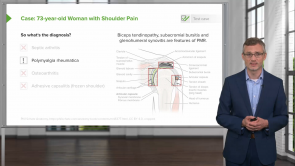Magnetic Resonance Imaging (MRI)

Über den Vortrag
Der Vortrag „Magnetic Resonance Imaging (MRI)“ von Hetal Verma, MD ist Bestandteil des Kurses „Case 206 (Body Interact) - additional lectures“. Der Vortrag ist dabei in folgende Kapitel unterteilt:
- Definition of MRI
- What is T1 and T2?
- MRI Safety
Quiz zum Vortrag
Which of the following is NOT true regarding an MRI scan?
- MRI uses ionizing radiation.
- Magnetic manipulation of hydrogen ions creates images.
- MRI is great for soft tissue abnormalities.
- It is an expensive technique.
- It takes a longer time than a CT scan.
Which of the following regarding T1 and T2 is FALSE?
- T2 refers to the time it takes for the protons to relax and align parallel to the magnetic field.
- T2 is one of the many different pulse sequences, which are predetermined imaging protocols, and are specific to the body part being scanned.
- A long echo time results in the T2 image and is the time between a radiofrequency pulse and the echo it creates.
- A short TR (repetition time) results in a T1 image.
- T1 and T2 refer to the length of time it takes for the protons to recover or return to their original alignment.
Which MRI appearance of the following different body structures is correctly matched to the pulse sequence?
- A renal cyst appears bright on a T2 weighted image.
- CSF fluid appears bright on a T1 weighted image.
- A hepatic cyst appears bright on the T1 weighted image.
- Fat in the abdominal wall appears dark in T2 weighted images.
- A hemorrhagic pancreatic lesion appears dark on a T1 weighted image.
What differentiates Fluid Attenuation Inversion Recovery (FLAIR) images from T2 weighted images?
- In FLAIR, the CSF fluid appearance is suppressed.
- In FLAIR, the CSF fluid is brighter than in T2.
- In T2, hemorrhagic lesions are brighter.
- In FLAIR, the gyri appear brighter than the sulci.
- In T2, the cerebral cortex appears more enhanced.
Which contrast is an agent of choice for MRI?
- Gadolinium
- Barium sulfate
- Chromium
- Arsenic
- Yttrium
Which situation is suitable for MRI to be performed?
- A 21-year-old football player with a probable anterior cruciate ligament injury.
- A 60-year-old male with a probable diagnosis of avascular necrosis of the right femoral head and a history of pacemaker implantation.
- An 11-year-old male with a head injury and a history of cochlear implants.
- A 35-year-old male on an insulin pump, scheduled for MRI for a pancreatic lesion.
- A 45-year-old male with eye pain with a probable metallic splinter in the eye.
Kundenrezensionen
3,2 von 5 Sternen
| 5 Sterne |
|
2 |
| 4 Sterne |
|
0 |
| 3 Sterne |
|
1 |
| 2 Sterne |
|
1 |
| 1 Stern |
|
1 |
Slide 9 is problematic, specifically for the explanation of T2. "Perpendicular" is not a very good term. There is no aforementioned information that would help explain what T2 is that is given in this lecture. What should have been said if this was to be avoided would be, "Beyond the scope of this lecture".
Not very informative. She seems to be nervous and runs very quickly through the slides.
Excellent lectures. If you could add on some lectures on radiography for head and neck region and CBCT for head especially maxilla and mandible, that would have been great.
Explanation of the T1 & T2 Terminology and how it works is lacking. Could have used way more slides to visualize this: MRI in Practice by C. Westbrook et al show how this can be done in Chapter 1. Important concepts which need to be properly explained, in this video it looks like it has been half heartedly done.





